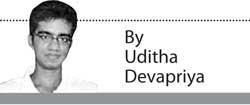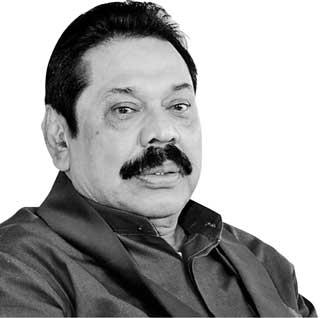Reply To:
Name - Reply Comment
Last Updated : 2024-04-25 22:12:00
 My father was the first in his family and my mother’s, to foretell Mahinda Rajapaksa’s rise to power in the 1990s. At the time the man was in charge of Labour and Vocational Training, a threadbare though challenging ministry if ever there was one. Challenging, not because one could not do much in it, but because by then the SLFP’s approach to labour had begun to depart from its traditional vantage point.
My father was the first in his family and my mother’s, to foretell Mahinda Rajapaksa’s rise to power in the 1990s. At the time the man was in charge of Labour and Vocational Training, a threadbare though challenging ministry if ever there was one. Challenging, not because one could not do much in it, but because by then the SLFP’s approach to labour had begun to depart from its traditional vantage point.

The populist-Left elements in the SLFP by that point had been relegated to a lower ground; in its place stood a neoliberal elite, differing only in degree, and not in substance, from the much more neoliberal UNP. When Mahinda tried to introduce a Workers’ Charter (which still hasn’t been seriously contemplated, much less proposed, even by those self-professed champions of liberal values lounging about at cocktail circuits) in parliament, for instance, Ravi Karunanayake shot it down immediately; Ravi’s parting shot, if I remember correctly, was that “we didn’t need a Charter to look after our workers!”
Back then it seemed to everyone but the most blinkered that the neoliberal Right was here to stay in the SLFP, even with Sirimavo Bandaranaike as Prime Minister. Some of Chandrika Kumaratunga’s appointments reflected this, including, but not limited to, her Cabinet (think of her replacement of Sunil Sarath Perera as Chairman of the SLBC by Wasantha Raja). Not surprisingly, Rajapaksa never figured in her scheme of things; by the time he took over the Prime Minister’s chair, he was handling Fisheries.
As such my father’s predictions, if you could call them that, were dismissed. The reason was simple enough; the Sinhala populist-nationalist crowd back then had rallied around the Hela Urumaya, following the trail left behind by Gangodawila Soma Thera.
I say this without optimism nor cynicism. Politics is a hard game, and those who play it must invariably be prepared to let the movements they found pass over to their cofounders
And yet, looking back now, it’s obvious that while the Hela Urumaya contributed much to the growth of a pan-Sinhala Buddhist consciousness, it couldn’t have achieved that much without Mahinda Rajapaksa’s intervention. Last week’s election confirmed this for all to see: Champika Ranawaka, who called the UNP “a pack of imperialists” in 2009, only to join that same pack six years later, got much, much less than even some of his critics bargained for, being topped by a neoliberal if not centre-right, non-Sinhala bloc.
So though my father seemed dead wrong in his predictions, history proved them right in the long run, even if that long run took a decade and a half to pass.
Initially, Mahinda Rajapaksa’s presidency did little to alter the status quo; there were the same calls for peace, the same emphasis on peace talks and ceasefires, the same line of continuity from the previous administration. But with the collapse of the ceasefire, the peace talks, and the peace, all that changed. The Mavilaru debacle (which commentators believed would be followed by the usual requests for mediation from Colombo) became Mahinda’s Rubicon. He could have chosen to cross, or to stay back.
The man chose to cross, to change history. That signalled, as we realised later on and realise even now, the culmination of everything leading to his electoral win.
Now to the subject of my piece.
The vindication of my father’s predictions inadvertently taught me four important lessons. The first is that no matter how strong a movement from outside the legislature may be, the moment it falls into the hands of a person or group within parliament, the role of that extra-parliamentary group, even after it joins the legislature,
becomes secondary.
The second is that this is true even if the extra-parliamentary group frequently claims to stand for the ideals which propelled that parliamentary leadership to power and claims that the person and party it campaigned for have now betrayed those ideals.
The third is that this is true even if that group switches allegiances, and attempts to win back the electorate taken over by the parliamentary leadership.
The fourth, the most important, is that this is true especially if the other side to which the group switches over represents, even temporarily, the very antithesis of its ideals.
Both the JVP and the JHU represented eagerly anticipated alternatives to the ruling parties a long time ago. And yet, if one thing brought them together, it wasn’t as much the milieu that crowded around them – then as now, these outfits are inhabited by changing layers of a Sinhala Buddhist petty bourgeoisie, one (JHU) more suburban middle class than the other (JVP) – as it was the man they crowded around. Mahinda.
2020 signalled the end of the relay for both parties because that man they selected as their partner in parliament trounced them decisively: reducing the JVP to three seats from a handsome 39 in 2004, and the JHU to a paltry one – Champika Ranawaka, in the SJB – from a respectable nine that same year. There can be no denying this.
Now the crisis of these once influential parties has nothing to do with their retreat from founding principles. Instead it has to do with their retreat from the man they helped prop up. As the only presidential figure to break through the mould (and the only such figure to produce a presidential brother), Mahinda Rajapaksa outwitted them all simply because he happened to be where he was when he assumed power: a populist vacuum. There was no one to fill that vacuum other than him; not even in 2014, as Maithripala Sirisena’s disastrous dalliance with the UNP proved in the long run.
But what’s important isn’t that the JHU-JVP combo lost, or that they almost won. What’s important is that at a time when people had grown tired of establishment politics, when everyone wanted a third option, people truly believed they had an alternative in the JVP and the JHU. The media (predominantly English) continued to demonise them as chauvinists and extremists – the same media that hails them as liberal types today – and when they joined Mahinda, it saw in him an extension of their values; thus once Mahinda beat them at their game and threw them overboard, he became the demonised villain. From that point on, the JVP and JHU could only abandon him by relinquishing vast swathes of their electorate. 2020, in that sense, merely confirmed what was ongoing for a long, long time.
In 2004 when the JVP and the JHU entered their peak, a war was being fought. By 2014, 10 years later, a different war had come to parliament: a clash of ideas between a populist and a neoliberal stream. It didn’t matter that sections of the Old Left sailed adrift the neoliberal tide or that sections of a federalist crowd sailed adrift the populist tide. What mattered was who sided with whom. In the end, the populists won.
Hence if the search for a nationalist-populist parliamentary presence “began” somewhere in 2004 when the JVP secured 39 seats and the JHU nine, it “ended” somewhere in 2018 when the Podu Jana Peramuna claimed a resounding 40% at the local elections.
My father’s lessons culminate here: The fact that neither of these two groups can rear its head as long as Mahinda, and Gotabaya, rule the roost. I say this with neither optimism nor cynicism. Politics is a hard game, and those who play it must invariably be prepared to let the movements they found pass over to their cofounders.
In any case, the Mahinda factor is here to stay. The Gotabaya factor has supplemented and not supplanted it. Any attempt at replacing them with an anti-populist front will provoke a backlash in the long term. Such a backlash can, as we have seen, summon enough power to obliterate even the oldest parties, personalities, and ideas. Thus could, and did, 2015 lead to 2020: the jettisoning of the SLFP and the UNP, the Chandrika-Ranil-Mangala troika and theJVP-JHU duo from parliament. Yes, history is cruel. But it is also inevitable.
UDAKDEV1@GMAIL.COM

Add comment
Comments will be edited (grammar, spelling and slang) and authorized at the discretion of Daily Mirror online. The website also has the right not to publish selected comments.
Reply To:
Name - Reply Comment
US authorities are currently reviewing the manifest of every cargo aboard MV
On March 26, a couple arriving from Thailand was arrested with 88 live animal
According to villagers from Naula-Moragolla out of 105 families 80 can afford
Is the situation in Sri Lanka so grim that locals harbour hope that they coul